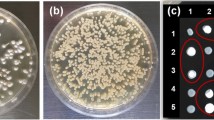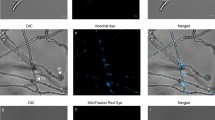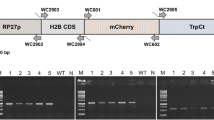Abstract
Background
Sporisorium scitamineum is the causative agent of smut disease in sugarcane. The tricky life cycle of S. scitamineum consists of three distinct growth stages: diploid teliospores, haploid sporidia and dikaryotic mycelia. Compatible haploid sporidia representing opposite mating types (MAT-1 and MAT-2) of the fungus fuse to form infective dikaryotic mycelia in the host tissues, leading to the development of a characteristic whip shaped sorus. In this study, the transition of distinct stages of in vitro life cycle and in planta developmental stages of S. scitamineum are presented by generating stable GFP transformants of S. scitamineum.
Methods and results
Haploid sporidia were isolated from the teliospores of Ss97009, and the opposite mating types (MAT-1 and MAT-2) were identified by random mating assay and mating type-specific PCR. Both haploid sporidia were individually transformed with pNIIST plasmid, harboring an enhanced green fluorescent protein (eGFP) gene and hygromycin gene by a modified protoplast-based PEG-mediated transformation method. Thereafter, the distinct in vitro developmental stages including fusion of haploid sporidia and formation of dikaryotic mycelia expressing GFP were demonstrated. To visualize in planta colonization, transformed haploids (MAT-1gfp and MAT-2gfp) were fused and inoculated onto the smut susceptible sugarcane cultivar, Co 97009 and examined microscopically at different stages of colonization. GFP fluorescence-based analysis presented an extensive fungal colonization of the bud surface as well as inter- and intracellular colonization of the transformed S. scitamineum in sugarcane tissues during initial stages of disease development. Noticeably, the GFP-tagged S. scitamineum led to the emergence of smut whips, which established their pathogenicity, and demonstrated initial colonization, active sporogenesis and teliospore maturation stages.
Conclusion
Overall, for the first time, an efficient protoplast-based transformation method was employed to depict clear-cut developmental stages in vitro and in planta using GFP-tagged strains for better understanding of S. scitamineum life cycle development.





Similar content being viewed by others
Data availability
Not applicable.
References
Zekarias Y, Dejene M, Tegegn G, Yirefu F (2010) Importance and status of sugarcane smut (Ustilago scitaminea) in the Ethiopian sugar estates. Ethiop J Agric Sci 20:35–46
Magarey RC, Sheahan TJ, Sefton M, Kerkwyk RE, Bull JI (2011) Yield losses from sugarcane smut: indications from Herbert mill data and from individual crop assessments. In: Bruce RC (ed) Proceedings of the 2011 Conference of the Australian Society of Sugar Cane Technologists. Australian Society of Sugar Cane Technologists, Australia, pp. 1–9
Sundar AR, Barnabas EL, Malathi P, Viswanathan R (2012) A mini-review on smut disease of sugarcane caused by Sporisorium scitamineum. In: Mworia JK (ed) Botany. InTech Rijeka, Croatia, pp 107–128
Alexander KC, Srinivasan KV (1966) Sexuality in Ustilago scitaminea Syd. Curr Sci 35(23):603–604
Izadi MB, Moosawi-Jorf SA (2007) Isolation and identification of yeast-like and mycelial colonies of Ustilago scitaminea using specific primers. Asian J Plant Sci 6:1137–1142
Prasher DC, Eckenrode VK, Ward WW, Prendergast FG, Cormier MJ (1992) Primary structure of the Aequorea victoria green-fluorescent protein. Gene 111(2):229–233
Chalfie M, Tu Y, Euskirchen G, Ward WW, Prasher DC (1994) Green fluorescent protein as a marker for gene expression. Science 263(5148):802–805
Lorang JM, Tuori RP, Martinez JP, Sawyer TL, Redman RS, Rollins JA, Wolpert TJ, Johnson KB, Rodriguez RJ, Dickman MB, Ciuffetti LM (2001) Green fluorescent protein is lighting up fungal biology. Appl Environ Microbiol 67:1987–1994
Cubitt AB, Heim R, Adams SR, Boyd AE, Gross LA, Tsien RY (1995) Understanding, improving and using green fluorescent proteins. Trends Biochem Sci 20:448–455
Spellig T, Bottin A, Kahmann R (1996) Green fluorescent protein (GFP) as a new vital marker in the phytopathogenic fungus Ustilago maydis. Mol Gen Genet 252:503–509
Sexton AC, Howlett BJ (2001) Green fluorescent protein as a reporter in the Brassica-Leptosphaeria maculans interaction. Physiol Mol Plant Pathol 58(1):13–21
Jansen C, Von Wettstein D, Schafer W, Kogel KH, Felk A, Maier FJ (2005) Infection patterns in barley and wheat spikes inoculated with wild-type and trichodiene synthase gene disrupted Fusarium graminearum. Proc Natl Acad Sci 102(46):16892–16897
Crespo-Sempere A, Lopez-Perez M, Martinez-Culebras PV, Gonzalez-Candelas L (2011) Development of a green fluorescent tagged strain of Aspergillus carbonarius to monitor fungal colonization in grapes. Int J Food Microbiol 148(2):135–140
Nandakumar M, Malathi P, Sundar AR, Viswanathan R (2020) Use of green fluorescent protein expressing Colletotrichum falcatum, the red rot pathogen for precise host-pathogen interaction studies in sugarcane. Sugar Tech 22(1):112–121
Ruiz-Diez B (2002) Strategies for the transformation of filamentous fungi. J Appl Microbiol 92(2):189–195
Sun L, Yan M, Ding Z, Liu Y, Du M, Xi P, Liao J, Ji L, Jiang Z (2014) Improved dominant selection markers and co-culturing conditions for efficient Agrobacterium tumefaciens-mediated transformation of Ustilago scitaminea. Biotechnol Lett 36:1309–1314
Carvalho G, Quecine MC, Longatto DP, Peters LP, Almeida JR, Shyton TG, Silva MML, Crestana GS, Creste S, Monteiro-Vitorello CB (2016) Sporisorium scitamineum colonisation of sugarcane genotypes susceptible and resistant to smut revealed by GFP-tagged strains. Ann Appl Biol 169(3):329–341
Li D, Tang Y, Lin J, Cai W (2017) Methods for genetic transformation of filamentous fungi. Microb Cell Fact 16(1):168
Madhavan A, Pandey A, Sukumaran RK (2017) Expression system for heterologous protein expression in the filamentous fungus Aspergillus unguis. Bioresour Technol 245:1334–1342
Barnabas L, Ashwin NMR, Sundar AR, Malathi P, Viswanathan R (2017) Putative orthologs of Ustilago maydis effectors screened from the genome of sugarcane smut fungus-Sporisorium scitamineum. Australas Plant Pathol 46(2):147–156
Abu Almakarem AS, Heilman KL, Conger HL, Shtarkman YM, Rogers SO (2012) Extraction of DNA from plant and fungus tissues in situ. BMC Res Notes 5:266. https://doi.org/10.1186/1756-0500-5-266
Yu J, Zhang Y, Cui H, Hu P, Yu X, Ye Z (2015) An efficient genetic manipulation protocol for Ustilago esculenta. FEMS Microbiol Lett. https://doi.org/10.1093/femsle/fnv087
Yan M, Cai E, Zhou J, Chang C, Xi P, Shen W, Li L, Jiang Z, Deng YZ, Zhang LH (2016) A dual-color imaging system for sugarcane smut fungus Sporisorium scitamineum. Plant Dis 100(12):2357–2362
Morocko-Bicevska I, Fatehi J (2011) Infection and colonization of strawberry by Gnomonia fragariae strain expressing green fluorescent protein. Eur J Plant Pathol 129(4):567–577
Liu XM, Qi YX, Zhang X, Xie YX, Zhang H, Wei YX, Cao SW, Pu JJ (2014) Infection process of Corynespora cassiicola tagged with GFP on Hevea brasiliensis. Australas Plant Pathol 43(5):523–525
Deng YZ, Zhang B, Chang C, Wang Y, Lu S, Sun S, Zhang X, Chen B, Jiang Z (2018) The MAP kinase SsKpp2 is required for mating/filamentation in Sporisorium scitamineum. Front Microbiol 9:2555. https://doi.org/10.3389/fmicb.2018.02555
Sun S, Deng YZ, Cai E, Yan M, Li L, Chen B, Chang C, Jiang Z (2019) The farnesyltransferase β-Subunit Ram1 regulates Sporisorium scitamineum mating, pathogenicity and cell wall integrity. Front Microbiol 10:976. https://doi.org/10.3389/fmicb.2019.00976
Van De Rhee MD, Graca PM, Huizing HJ, Mooibroek H (1996) Transformation of the cultivated mushroom, Agaricus bisporus, to hygromycin B resistance. Mol Gen Genet MGG 250(3):252–258
Frandsen RJN (2011) A guide to binary vectors and strategies for targeted genome modification in fungi using Agrobacterium tumefaciens-mediated transformation. J Microbiol Methods 87(3):247–262
Visser M, Gordon TR, Wingfield BD, Wingfield MJ, Viljoen A (2004) Transformation of Fusarium oxysporum f. sp. cubense, causal agent of Fusarium wilt of banana, with the green fluorescent protein (GFP) gene. Australas Plant Pathol 33(1):69–75
Marques JPR, Appezzato-da-Gloria B, Piepenbring M, Massola NS Jr, Monteiro-Vitorello CB, Vieira MLC (2017) Sugarcane smut: shedding light on the development of the whip-shaped sorus. Ann Bot 119(5):815–827
Dunn AR, Fry BA, Lee TY, Conley KD, Balaji V, Fry WE, McLeod A, Smart CD (2013) Transformation of Phytophthora capsici with genes for green and red fluorescent protein for use in visualizing plant-pathogen interactions. Australas Plant Pathol 42(5):583–593
Wu L, Conner RL, Wang X, Xu R, Li H (2016) Variation in growth, colonization of maize, and metabolic parameters of GFP-and DsRed-labeled Fusarium verticillioides strains. Phytopathology 106(8):890–899
Trione EJ (1980) Teliospore formation by Ustilago scitaminea in sugarcane. Phytopathology 70:513–516
Kato A, MiyakeT NK, Tateishi H, Teraoka T, Arie T (2012) Use of fluorescent proteins to visualize interactions between the Bakanae disease pathogen Gibberella fujikuroi and the biocontrol agent Talaromyces sp. KNB-422. J Gen Plant Pathol 78(1):54–61
Talhinhas P, Muthumeenakshi S, Neves-Martins J, Oliveira H, Sreenivasaprasad S (2008) Agrobacterium-mediated transformation and insertional mutagenesis in Colletotrichum acutatum for investigating varied pathogenicity lifestyles. Mol Biotechnol 39(1):57–67
Weld RJ, Plummer KM, Carpenter MA, Ridgway HJ (2006) Approaches to functional genomics in filamentous fungi. Cell Res 16(1):31–44
Zhang B, Cui GB, Chang CQ, Wang YX, Zhang HY, Chen BS, Deng YZ, Jiang ZD (2019) The autophagy gene ATG8 affects morphogenesis and oxidative stress tolerance in Sporisorium scitamineum. J Integr Agric 18(5):1024–1034
Acknowledgements
The authors are grateful to The Director, ICAR-Sugarcane Breeding Institute for providing facilities and continuous encouragement. The financial support received from Department of Biotechnology (DBT), Department of Science and Technology - Science and Engineering Research Board (DST-SERB) and Indian Council of Agricultural Research (ICAR), New Delhi are greatly acknowledged. We greatly acknowledge Dr. Rajeev Sukumaran, CSIR- National Institute for Interdisciplinary Science and Technology, Trivandrum, Kerala for sharing the pNIIST plasmid.
Funding
This work was financially supported by the Department of Biotechnology (DBT) (Sanction No. BT/PR12883/BPA/118/142/2015) and Department of Science and Technology - Science and Engineering Research Board (DST-SERB) (Sanction Order No. EMR/2016/006055) in the form of research grants to the corresponding author.
Author information
Authors and Affiliations
Contributions
V. N. A., N. M. R. A. and A. R. S. conceived and designed the experiments. V. N. A. performed the experiments and wrote the first draft of the manuscript. N. M. R. A., R. T. V. and K. N. are involved in analyzing the results and in revising the manuscript. A. R. S., N. M. R. A., P. M. and R. V. shared their expertise in execution of experiments, and were involved in revising and improving the intellectual content of the manuscript. All authors read and approved the final manuscript.
Corresponding author
Ethics declarations
Conflict of interest
The authors declare that they have no conflict of interest in the publication.
Ethical approval
The present research work did not involve human participants and/or animals.
Consent to participate
Not applicable.
Consent for publication
Not applicable.
Additional information
Publisher's Note
Springer Nature remains neutral with regard to jurisdictional claims in published maps and institutional affiliations.
Supplementary Information
Below is the link to the electronic supplementary material.
Rights and permissions
About this article
Cite this article
Agisha, V.N., Ashwin, N.M.R., Vinodhini, R.T. et al. Protoplast-mediated transformation in Sporisorium scitamineum facilitates visualization of in planta developmental stages in sugarcane. Mol Biol Rep 48, 7921–7932 (2021). https://doi.org/10.1007/s11033-021-06823-x
Received:
Accepted:
Published:
Issue Date:
DOI: https://doi.org/10.1007/s11033-021-06823-x




